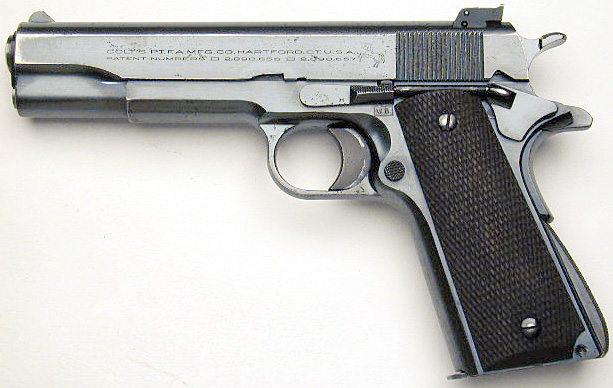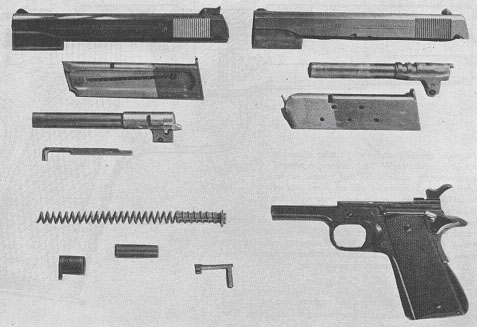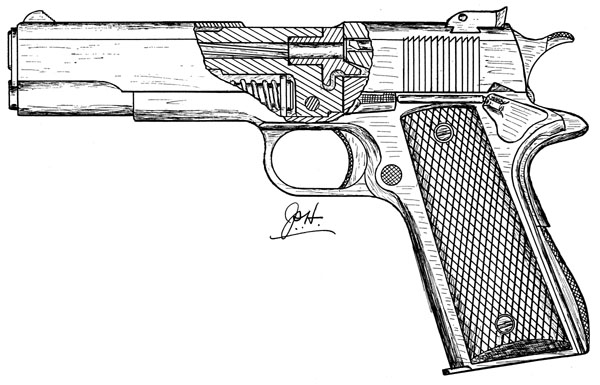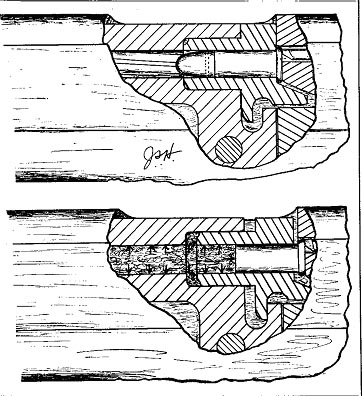|

Colt Service Model Ace serial number SM2966
THE SERVICE .45 automatic pistol is an extremely accurate
gun, but for good shooting to be had with this or any other
pistol the user must have a certain degree of training with
his weapon and proficiency in its use. To expect a man to do
good pistol shooting without practice is nearly as absurd as
to expect him to swim without ever having been in the water
or to play a good game of golf without having had a golf
club in his hand.
Now there are good and bad ways of teaching anything, and
the bad way to teach pistol shooting is to place a highpower
loaded gun in the novice's hand and a target in front of him
and let him go ahead as though he were entirely familiar
with what he is doing. This is such a bad way to teach
pistol shooting that the chances are that instead of making
a man into a good pistol shot it will lay the foundations
for making him a thoroughly bad one. In the first place, the
pupil will lack co-ordination between hand, wrist, and eye.
The gun will feel clumsy and awkward in his hand. The sights
will be difficult to align. He will jerk the trigger instead
of pulling it smoothly. If in this stage of his training he
attempts to do actual shooting, he will have such difficulty
in hitting the target at all that his confidence may be
forever destroyed.
Obviously the first thing to do is to let him practice
aiming and snapping with an unloaded gun until the necessary
muscular and nervous co-ordination is obtained. Even when
this stage is reached, it is a mistake to let him use
high-power cartridges for his first actual shooting, for he
has not yet had any experience with the noise and recoil of
the large calibers. Thus his anticipation of the explosion
and disturbance which he knows will come when the trigger is
pulled will cause a nervous strain which is very likely to
result in flinching. And the habit of flinching, when once
acquired, is very hard to get rid of, especially as the kick
of the pistol will mask the flinch to such an extent that
the user will be unconscious of it.
Experience has shown that the way to overcome these
difficulties and lay a solid foundation for good pistol
marksmanship is to progress from "dry shooting" or snapping
practice with the empty gun, to actual target practice with
.22 caliber cartridges. The .22's make relatively little
noise or disturbance, hence all nervousness on that account
is removed; yet they are so superbly accurate that the
scores made on the target will give a perfect record of the
proficiency of the shooter.
Another advantage of the .22 long rifle as a practice
cartridge is the fact that it costs just one-seventh the
price of the .45; in other words, for the same expenditure
of funds the shooter can indulge in seven times as much
practice as he could if he were using the larger caliber.
Moreover, owing to its comparatively low power, practice can
be carried on in many places where shooting with a .45 would
be impossible.

How the .45 is changed to .22 caliber:
The Service Model Ace parts, upper left, are substituted for
the .45-caliber parts, upper right. Parts shown in lower
half of picture are common to both calibers.
For the reasons just mentioned it will be seen that the
.22 as a practice cartridge is ideal, not only for the
beginner, but also for the accomplished pistol shot who
wants to keep his hand in by shooting from time to time.
From the viewpoint of the owner of a .45 automatic, it
will be seen that what is wanted is a .22 caliber automatic
pistol that will duplicate the size, shape, balance, feel,
and action of the regular .45 automatic; or even better,
since the gun is readily taken apart without tools, a .22
magazine, barrel, and slide which can be used
interchangeably with the regular parts to allow the gun to
be converted from .45 to .22 and back again.
These facts have long been recognized by the makers of
the .45 automatic, but such formidable engineering
difficulties lay in the way that it is only recently that
the problem has been solved by the use of the "Floating
Chamber", an amazingly effective invention which is so
simple that it is surprising that it was not thought of
before.
It is interesting to note that this new idea did not
originate in the highly trained technical organization of
some big arms company, but instead was the work of a young
man working entirely on his own in an auto repair shop in a
small country town.
The inventor, Mr. David M. Williams, of Godwin, North
Carolina, thought out the idea for himself, and then
proceeded to make up and try out a high power rifle, a .22
caliber rifle, and a .45 caliber pistol converted to .22
caliber, each using the floating chamber principle. He did
the work himself, using for material what scrap automobile
parts he could find around the shop that seemed to him to
have the required strength. Most of his parts were made from
old Ford rear axles.
When his models were completed, it was to this writer
that Mr. Williams brought them for his first demonstration,
with the idea that the Government might be interested in
having him make up a military rifle on this principle. It
required only a very brief examination of his guns and a few
minutes talk with the designer to show that he had a
tremendous lot of gun knowledge, and that everything he had
done had been reasoned out most carefully, by the aid of
good hard common sense, and that in addition he was a born
mechanical genius. Like that outstanding figure of the gun
world, the late Mr. John Browning, Mr. Williams is a
"natural". And like Mr. Browning, he is quiet and
unassuming, and is a man of few and simple words, who does
his own thinking.
The models Mr. Williams brought in looked so good and
shot so well that he was given a contract to convert a .30
caliber Browning Machine Gun so that it would shoot .22
caliber cartridges automatically from a belt. The Army had
long wanted such a gun for training purposes, but most
experts were of the opinion that such a gun could not be
produced. Mr. Williams accomplished the job in just six
weeks, and his .22 caliber Browning Machine Gun is now
standard in the Army for short range or indoor training.
His .22 conversion of the .45 also looked good, but as it
was based on the existing .45 automatic made by Colt's, he
was advised to take his invention to them, and was given a
letter of introduction to the president of the company. The
result was that he made an agreement with Colt's for them to
use the Williams Floating Chamber, making a new .22 caliber
automatic pistol.

Diagram showing action of floating chamber in Colt Service Model Ace. Barrel is
pinned to receiver by slide stop, and cannot move. Upon firing, pressure of gas
on front end of movable chamber drives same to rear until lug on bottom strikes
corresponding lug on barrel, and stops the motion. As floating chamber rests
against breech block, which is part of slide, this motion is transmitted to
slide, which is thus thrown to rear against action of recoil spring, at same
time cocking hammer and compressing mainspring.Before describing
this device and the new Colt "Service Model Ace" .22 which
it made possible, let us say just a few words to avoid any
possible confusion between the new Service Model Ace and the
regular Colt Ace .22 Automatic which has been on the market
for several years.
In designing the regular Ace, the makers were constantly
faced by the fact that the .22 long rifle cartridge lacks
sufficient power to drive a heavy slide back against its
recoil spring, at the same time cocking the hammer against
its mainspring. Add to the basic fact that the cartridge
lacks recoil power to operate a heavy automatic the further
fact that there are over 50 various makes, kinds and types
of .22 long rifle cartridge, and that the public will expect
the gun to handle any one of them equally well, and you can
see what a problem was involved.

IMAGE - Action of the floating chamber in the Colt Service Model Ace Upper.•
Position of parts at instant of firing. Floating chamber, with cartridge, is
held forward by slide, under pressure of recoil spring. Barrel is held fast to
receiver, and cannot move.Lower: Gun has just been fired, and gas pressure (indicated by arrows on the
sketch) acts on inside surface of cartridge head and on front face of chamber to
drive chamber, cartridge case, and slide to rear. When floating chamber has
moved a short distance to position shown, its motion is arrested by lip on
bottom, which strikes corresponding lip on barrel. Momentum which slide has
acquired carries it on to rear, and empty cartridge is drawn with it by
extractor
In order to insure that the Ace would always
give automatic functioning, it was necessary to lighten the
slide, the recoil spring, and the mainspring as much as
possible, as well as to change several other parts so that
they were different from those in the .45. For this reason
it was not possible to furnish the Ace slide, barrel, and
magazine to be fitted onto the frame of the .45. The pistol
had to be fitted and sold as a unit. Because the slide and
the springs are made as light as possible, the recoil is
very light and the slide makes little disturbance in going
shut, so that the regular Colt Ace is a very pleasant gun to
shoot.
However, for some purposes, a rather sharp
recoil and a consequent disturbance of aim are desirable. A
.22 Automatic that gives a good strong kick will more
closely simulate the action of the .45 and will consequently
give better rapid fire practice for the man who is preparing
for service pistol matches.
That is exactly what the new Colt Service
Model Ace gives. The "floating chamber" practically
quadruples the recoil power of the .22 long rifle cartridge,
and the result is a recoil that strongly reminds the user of
the .45, though in fact it is considerably less. And this
increased recoil means that the gun has ample power to
enable it to work under almost any conditions. This extra
power makes it unnecessary to reduce the weight of the slide
or the strength of the recoil spring or the mainspring. Thus
it is now possible to furnish only the .22 caliber magazine,
slide, and barrel with ejector, which will fit onto any Colt
.45 receiver in place of the regular parts.
The accompanying sectional sketch shows what
the Floating Chamber is and how it works. Instead of having
the cartridge chamber integral with the barrel, it is in a
separate cylindrical piece which fits into a corresponding
recess in the barrel and is free to move back a short
distance independently of the barrel.
When the ordinary.22 Automatic is fired, the
force which drives the breech block backward against its
spring, and thus opens the gun, is the pressure of the
powder gas on the inside of the cartridge head. As mentioned
above, this force is insufficient to operate the heavy slide
against the hammer and mainspring of the Service .45.
In the Service Model Ace, this pressure acts
on the inside of the cartridge head as described, but this
is only a relatively small part of the power that is
applied, for the powder gas also gets into the space between
the barrel and the front end of the movable chamber, and
acting on its comparatively large front surface, drives the
entire movable chamber, cartridge and all, to the rear
against the slide. The force thus exerted is roughly four
times that available through the cartridge head alone. Thus
the .22 caliber cartridge has its recoil power multiplied
sufficiently to operate a heavy slide against a stiff
spring, and at the same time to give the entire gun a kick
that gives the illusion that a large caliber automatic is
being used.
The amount of power used, and the strength
of the resultant kick can be made almost anything desired by
changing the outside diameter of the floating chamber and
the distance through which it is allowed to move backward.
Among the advantages gained by the use of
this clever invention are the following:
-
It gives sufficient reserve power to
insure certainty of functioning, even with old or
inferior ammunition.
-
It produces a recoil that sufficiently
simulates the action of the .45 so that the gun must be
re-aligned on the target after each shot, thus making it
possible to obtain extremely effective rapid fire
practice
-
The reserve power available makes it
possible to supply .22 caliber parts which will fit on
the regular .45 caliber receiver and can be depended on
to work even when old guns are used which are of
war-time manufacture or otherwise not up to standard.
This idea of making a gun barrel in two
pieces, one of which slides within the other and-with a gap
for the bullet to jump, may at first thought seem somewhat
radical, and no doubt this is the reason that such a gun was
not put on the market long before. But a little reflection
will show that essentially the same thing has been used for
years in revolvers, where the cartridge chambers are
contained in a cylinder which is not a part of the barrel at
all, and is actually separated from it by quite a gap across
which the bullet must jump.
If we should describe these two systems to a
man who was totally unacquainted with firearms, and ask him
which was the better system, he would no doubt say that from
an engineering viewpoint the Service Model Ace is better,
because the chamber is held in positive alignment with the
barrel at all times, and there is no open passage for the
escape of powder gas between the barrel and the chamber, as
there is in the revolver.
The question has been asked as to whether or
not there is any chance of trouble from corrosion between
the barrel and the floating chamber. There is no reason to
expect trouble from this cause, for the floating chamber is
readily removable with the fingers alone, and is easy to
clean if cleaning ever becomes desirable. But with modern
noncorrosive ammunition the old practice of cleaning the gun
each time it is fired is entirely unnecessary, though of
course a gun like any other metal object should be oiled
before being put away for long periods.
As a practical test of the possibilities of
trouble from this cause, all cleaning of either the barrels
or the movable chambers has been omitted during several
weeks of almost daily firing of a complete Service Model Ace
and of a set of .22 parts on an old .45 receiver. Not the
slightest trouble has been encountered and the parts look
just as they did when they were received.
As a check on the amount of reserve power
made available by the floating chamber, old and deteriorated
ammunition was purposely used in a large percentage of this
shooting, and whenever the cartridges would go off at all,
the slide would open all the way and the gun would function,
showing that there is plenty of power and some to spare for
even the weakest .22 long rifle cartridge. By loading them
one at a time (because they would not fit in the magazine),
.22 shorts were also tried. While they made excellent
groups, they did not fully open the slide, as the end of the
floating chamber does not come at the right place in
relation to the peak of the pressure curve. The gun could,
however, easily be made to operate with shorts by giving
suitable dimensions to the floating chamber.
As may be inferred from what has already
been said, the Colt Service Model Ace .22 can be had either
as a complete gun, or as .22 parts only, for use on the
receiver of a .45 automatic already on hand.
The Service Model Ace offers a most
effective method of training for proficiency with the
Service pistol, and such an economical one that the amount
saved on ammunition in just a few days' practice will pay
for the gun. Because of those very features which make it an
excellent training arm -- recoil, service trigger pull, etc.
-- the Service Model Ace will probably not appeal to the man
who is interested solely in a target pistol for competition
in .22 events. Here the Woodsman and Hi-Standard with their
light recoil, lighter trigger pull and less "sensitive"
grips remain better. Source: American
Rifleman, Jun 1938. Vol 86, number 6 |